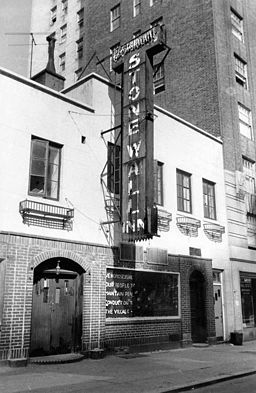In the early hours of Saturday, June 28, 1969, police raided the Stonewall Inn, a gay bar at 53 Christopher Street in New York City, and bar employees were arrested for serving liquor without a license and other violations. However, when four patrons were forced into the police van, a crowd of onlookers and bar patrons, fed up with feeling targeted and ostracized, began throwing bottles at the police, and the now-infamous riot erupted.

This event and further riots and protests in the following nights were to be the defining moment in the modern LGBT Rights Movement. The event was the motivation behind the organization of the first pride march and, later, LGBT pride marches on a wider public scale.
On November 2, 1969, a resolution at the Eastern Regional Conference of Homophile Organizations meeting in Philadelphia established the first pride march to be held in New York City. Craig Rodwell, Fred Sargeant, Ellen Broidy and Linda Rhodes proposed an Annual Reminder, encompassing the ideas and ideals of the struggle for fundamental human rights within the gay, lesbian, bisexual and transgender community.
They proposed that the demonstration be held annually on the last Saturday in June in New York City and called on similar organizations throughout the country to hold parallel demonstrations in a nationwide show of support in commemoration of the 1969 spontaneous demonstrations on Christopher Street. The demonstration would be called Christopher Street Liberation Day.
On June 28, 1970, the first anniversary of the Stonewall riots, marchers assembled on Christopher Street and the first LGBT Pride march began its march for 51 blocks to Central Park.
As the New York Times reported on its front page the next day, thousands marched from Greenwich Village to the Sheep Meadow in Central Park declaring “the new strength and pride of the gay people.”

“From Washington, Boston and Cleveland, from Ivy League colleges, from Harlem, the East Side and the suburbs, they gathered to protest laws that make homosexual acts between consenting adults illegal and social conditions that often make it impossible for them to display affection in public, maintain jobs or rent apartments,” wrote Times reporter Lacey Fosburgh.
“We’re probably the most harassed, persecuted minority group in history, but we’ll never have the freedom and civil rights we deserve as human beings unless we stop hiding in closets and in the shelter of anonymity,” said Michael Brown, one of the founders of the Gay Liberation Front, an activist organization that had been holding small demonstrations in Greenwich Village over the past year. “We have to come out into the open and stop being ashamed, or else people will go on treating us as freaks. This march is an affirmation and declaration of our new pride.”
The marchers held bright red, green, purple and yellow silk banners, and moving up Avenue of the Americas, chanted, “Say it loud, gay is proud.”

The line of marchers extended for 15 blocks and included members of the Gay Activists Alliance, the Mattachine Society, women’s liberation groups, the Queens and 14 other LGBT organizations.
Estimates of the size of the demonstration ranged from 3,000 to 20,000, according to organizers.
“We’ve never had a demonstration like this,” Martin Robinson of the Gay Activities Alliance told the Times. “It serves notice on every politician in the state and nation that homosexuals are not going to hide any more. We’re becoming militant, and we won’t be harassed and degraded anymore.”
Crowds of people stood in silence on the sidewalks along the Avenue of the Americas as the demonstration moved toward its destination of Central Park.
“Some eagerly clicked their cameras, others tittered, many were obviously startled by the scene. There was little open animosity, and some bystanders applauded when a tall, pretty girl carrying a sign, ‘I am a Lesbian,’ walked by,” Fosburgh wrote.
Holding a yellow silk banner high in the air, Michael Kotis, president of the Mattachine Society, said, “The main thing we have to understand is that we’re different, but we’re not inferior.”
Every June, thousands come to New York City to celebrate the LGBTQ community, attending the historic Pride March as well as other Pride events occurring throughout the month leading up to the march itself.
